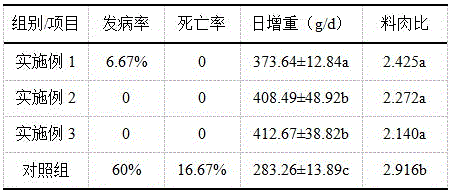A kind of pig feed mycotoxin degradation adsorbent and its application
A technology of mycotoxins and adsorbents, which is applied in the field of mycotoxin degradation adsorbents for pig feed, can solve problems such as difficult promotion and use, inconclusive safety of transformation products, and heat-resistant enzymes, so as to reduce disease hazards and economic losses. Significant dual effects of degradation and adsorption, and the effect of promoting the excretion of poisons
- Summary
- Abstract
- Description
- Claims
- Application Information
AI Technical Summary
Problems solved by technology
Method used
Image
Examples
Embodiment 1
[0048] 1. The formula for preparing the mycotoxin-degrading adsorbent in this example is as follows:
[0049] Each component by weight is: Bacillus subtilis (YB4) 15 grams, Lactobacillus plantarum (R1) 10 grams, Lactobacillus acidophilus (R4) 10 grams, Leuconostoc lactis 5 grams, Lactobacillus delbrueckii 5 grams, 5 grams of Lactobacillus fermentum and 5 grams of Lactobacillus salivarius, 10 grams of vitamin C, 10 grams of vitamin E, 20 grams of astragalus, 10 grams of zinc methionine, 20 grams of potassium chloride, 20 grams of cinnamon, 10 grams of cloves, 15 grams of capillary, 20 grams of mugwort leaves, 10 grams of Artemisia annua, 20 grams of wild chrysanthemum, 15 grams of plantain seed, 30 grams of yeast cell wall, 1 gram of phytase (content 20000U / g).
[0050] 2. Preparation method: According to the proportion of the formula, all the raw materials are pulverized, mixed, and vacuum packed.
[0051] 3. How to use: Add 0.2% mycotoxin-degrading adsorbent to the full-pric...
Embodiment 2
[0053] The formula for preparing mycotoxin degrading adsorbent in this embodiment is as follows:
[0054] Each component by weight is: Bacillus subtilis (YB4) 20 grams, Lactobacillus plantarum (R1) 15 grams, Lactobacillus acidophilus (R4) 15 grams, Leuconostoc lactis 10 grams, Lactobacillus delbrueckii 10 grams, 10 grams of Lactobacillus fermentum and 10 grams of Lactobacillus salivarius, 15 grams of vitamin C, 15 grams of vitamin E, 25 grams of astragalus, 15 grams of zinc methionine, 25 grams of potassium chloride, 25 grams of cinnamon, 15 grams of cloves, 20 grams of capillary, 25 grams of mugwort leaves, 15 grams of Artemisia annua, 25 grams of wild chrysanthemum, 20 grams of plantain seed, 40 grams of yeast cell wall, 1 gram of phytase (content 20000U / g).
[0055] The preparation method and usage method are the same as in Example 1, and will not be repeated.
Embodiment 3
[0057] The formula for preparing mycotoxin degrading adsorbent in this embodiment is as follows:
[0058] Each component by weight is: Bacillus subtilis (YB4) 25 grams, Lactobacillus plantarum (R1) 20 grams, Lactobacillus acidophilus (R4) 20 grams, Leuconostoc lactis 15 grams, Lactobacillus delbrueckii 15 grams, 15 grams of Lactobacillus fermentum and 15 grams of Lactobacillus salivarius, 20 grams of vitamin C, 20 grams of vitamin E, 30 grams of astragalus, 20 grams of zinc methionine, 30 grams of potassium chloride, 30 grams of cinnamon, 20 grams of cloves, 25 grams of capillary, 30 grams of mugwort leaves, 20 grams of Artemisia annua, 30 grams of wild chrysanthemum, 25 grams of plantain seed, 50 grams of yeast cell wall, 1 gram of phytase (content 20000U / g).
[0059] The preparation method and usage method are the same as in Example 1, and will not be repeated.
PUM
 Login to View More
Login to View More Abstract
Description
Claims
Application Information
 Login to View More
Login to View More - R&D
- Intellectual Property
- Life Sciences
- Materials
- Tech Scout
- Unparalleled Data Quality
- Higher Quality Content
- 60% Fewer Hallucinations
Browse by: Latest US Patents, China's latest patents, Technical Efficacy Thesaurus, Application Domain, Technology Topic, Popular Technical Reports.
© 2025 PatSnap. All rights reserved.Legal|Privacy policy|Modern Slavery Act Transparency Statement|Sitemap|About US| Contact US: help@patsnap.com


